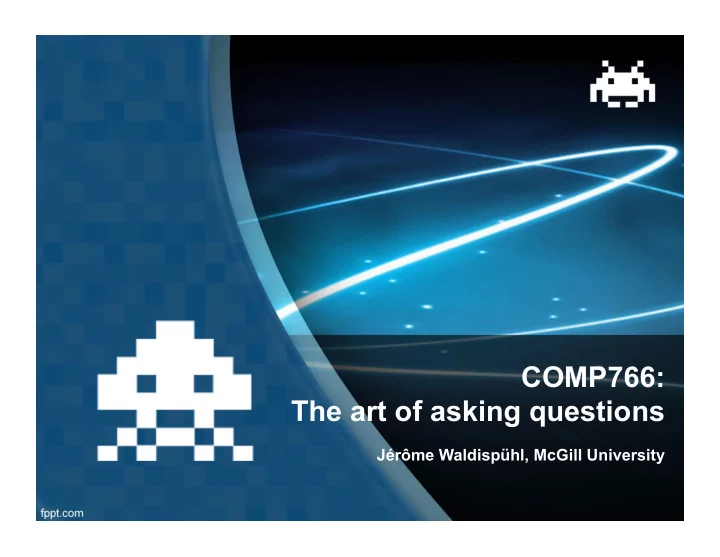

COMP766: The art of asking questions Jérôme Waldispühl, McGill University
What is a task? A task has 3 main components: • Basic information o Inputs o Question o Output • Condition of success • Incentives
Design principles • Information • Granularity • Independence • Incentive • Quality control
Gambler's fallacy Common belief: If you tossed 4 heads in a row, the probability of have a tail at the next step is higher. The probability of having 4 heads followed by one tail is the same than having 5 consecutive heads! More at: http://en.wikipedia.org/wiki/List_of_biases_in_judgment_and_decision_making
Negative bias in sequence of HITs Blurry Blurry
Negative bias in sequence of HITs Clear Clear
Iterative tasks • Iteration can help to improve existing solutions, (Little et al. , 2010) • Iteration may also prevent creativity… (Little et al. , 2010)
Maximal granularity Find-Fix-Verify pattern yields better results in word processor Soylent. Why? Better management of the crowd. (berstein et al. , 2010)
Empirical studies suggest different trade-offs • 38 image tagging HITs with various in complexity & reward, • use results as training data. Conclusion: Complex and rewarding HITs are more effective. (Huang et al. , 2010)
Beyond simple tasks Collaborative editing : www.etherpad.org
How do humans work together? www.pardus.at • massive multiplayer browser game, • 470,000 registered, 16,000 active players at any time, • played since sep. 2004, • free, optional 5$/month.
How do humans work together? How do communities grow? Some actions and links can be predicted. Information is useful to design collaborative systems and design routing. (Zhell & Thurner, 2009, 2012)
Create incentives • Level of participation, • Quality of the task assignment, • Accuracy of the answer.
Extrinsic vs. intrinsic motivations Extrinsic: Money, trophy, reward… Intrinsic: Power, curiosity, status, social contact, competition, idealism... Important, are connected but impact on the quality of the work is still unknown.
Some rules on extrinsic incentives • Some worker have clear money objectives: Paying the right price is important, • Free could be better than too small reward. • Extrinsic incentive can motivate workers to not game the system (good task with expertise vs easy ones) • Currently system are using fixed price but dynamic pricing should be explored.
Validation Standard techniques: • Automatic verification • Vote for the best output (voting) • Vote for the worst output (filtering) • Merging These techniques can be augmented with an a priori control. Kittur et al. (2008) showed that a verifiable questions before subjective ones help to reduce invalid answers by 43%.
Vickey-Clarke-Groves Mechanism How to price an apple? The client with the highest bid win the auction but pay the price offered by the other client. Objective: Design a system where participants benefit the most to answer correctly.
ESP Game Grass Sheep's +10 White Sheep Sheep Sheep (von Ahn and Dabbish, 2004)
Output agreement 3 axes of the ESP games: • Independence : tags are generated independently. • agreement : An agreement indicate higher trust. • shared information : Only the image is shared and thus the search space is reduced. Seminal example of an output agreement mechanism.
Challenges in output agreement Output agreement is efficient for simple tasks. For more complex tasks (E.g. audio tagging) this mechanism is inefficient. An audio version of ESP showed that 36% of the gamers skip the game before entering any valuable tag.
Tag-a-tune • Each player is given a song. • Player exchange tags to determine if the song are identical. (E. Law et al., 2007)
Input agreement Input agreement is an instance of the function computation mechanisms: • Partial input (e.g. song) • Computation (e.g. generate tags) • Evaluate an auxiliary function (e.g. the songs are the same) By allowing communication between players, input agreement are noisy.
Input vs. Output Agreement (E. Law, 2012)
Asymmetric function computation • Only Guesser compute the function, • Communication is unidirectional. (von Ahn et al., 2006)
Prevention of bad behaviors How to prevent common & uninformative tags? Create incentive for diversity: • Reward (Google Image Labeller) • Restrictions (E.g. taboo words) But restriction can be counter-productive.
KissKissBan In ESP, a third player (adversary) enters words to block the team. (Ho et al. , 2009)
Complementary agreement • Positive player : Select words that describe a concept. • Negative player : Select words that do not describe a concept. Players alternate their role and score when the word match. BUT the player receive penalties if the a word is tagged as positive and negative simultaneously!
3 central aspects What operations to perform What How to To whom are perform the assigned the operations operations How Who Human-computer system
Designing HIT Input Output Task routing Task design Task aggregation
Reference Human Computation Edith Law, Luis von Ahn Morgan & Claypool Publishers
Recommend
More recommend